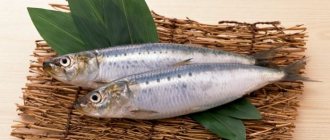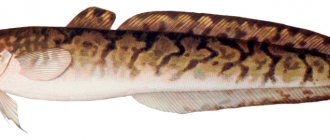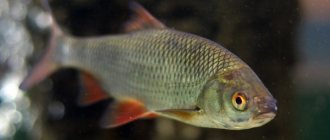Characteristics of the species
There are a total of five varieties of fish presented:
- blue or light blue;
- striped;
- spotted;
- Far Eastern;
- acne.
Regardless of the species, catfish are famous for their scary appearance. She is notable for her protruding wolf fangs, which only add to the ugliness and give rise to various creepy tales. Previously, the head of a catfish served as a real trophy, and all thanks to its predatory mouth, which is very similar to a wolf’s.
In ancient times, people used it as a frightening decoration to ward off uninvited guests, and sailors created entire legends in which the catfish was the main predator, devouring all living things. In principle, there is nothing surprising here, because the photograph shows how terrifying she looks. It is often confused with moray eels or large eels, because they also have a curved body, although they belong to completely different families.
Yandex.Pictures
Description
Catfish is also called sea wolf or sea devil due to the fact that it does not have a very pleasant appearance.
In addition, her teeth are somewhat reminiscent of a dog’s: in front there are fangs that protrude slightly forward, and there are also several fairly strong grinding teeth located on the jaws and palate. What is noteworthy is that catfish have only pectoral fins, but no pelvic fins. Below you can familiarize yourself with the general characteristics of the fish, its varieties, beneficial properties, as well as options for preparing catfish at home and what dishes this fish can be used in.
Blue (light blue)
What family of fish does catfish belong to? The blue or blue species is part of the order Scorpiformes and is a close relative of the Perciformes. They lived back in the Cenozoic era, or approximately 60 million years ago.
The main difference between the blue catfish is the structure of the body - the body is slightly raised closer to the rounded head and tapers towards the tail, the skin is dense and covered with small scales. They can boast a long dorsal fin, which consists of 78 soft rays, the rear fin is shortened by almost half, and the caudal fin is rounded.
The blue catfish reaches a length of 1.8 m, a maximum weight of 20 kilograms, and an age of up to 20 years. Maturity is reached at 5 or 5 and a half years, when the length of the fish is already at least 75 centimeters. The female can lay up to 40,000 eggs, and the male will bravely defend his family.
The teeth are very similar to fangs and occupy several rows at once - on the jaw, palate and on the bone plate. It is thanks to its predatory and tenacious teeth that not a single prey can escape from the catfish’s mouth. Moreover, they have an interesting property - they are updated once a year. During this period, the sea wolf has to eat exclusively soft food or go into hibernation, because the change of teeth occurs in winter.
Yandex.Pictures
An interesting fact is that the scariest or ugliest males are truly jealous and monogamous. Choosing a female for themselves, they stay with her forever, not forgetting to scare away other males with their powerful fangs.
Social structure and reproduction
Photo: Northern catfish
According to gender, catfish are divided into male and female. The former are characterized by increased dimensions. The male color is much darker. Female catfish are cuter. They have no swelling around the eyes, and their lips are less massive. The chin of females is less pronounced. Their color is lighter.
Interesting fact: Male catfish are monogamous. The fight for the female is carried out only once. At the same time, the word “fight” is used in the literal sense: fish carry out full-fledged fights, fighting with each other with their heads and teeth (scars from such battles remain forever on the body of sea inhabitants). After taking possession of a catfish, the male remains faithful to it for the rest of his life.
In the northern regions, catfish spawning occurs mainly in the summer months. And in warmer latitudes, reproduction is possible in winter. One female can produce up to 40 thousand eggs with a diameter of about 5 mm. Glued into a ball, the embryos adhere to the surface (most often stones). Development takes a significant period of time. In cold waters, fry may be born only after several months. Hatched fish at the beginning of their life journey live in high layers. They go to one only when they reach a length of 5-8 cm. With such dimensions, they can hide and start hunting. The fry feed on zooplankton.
Interesting fact: Male catfish are not only monogamous, but also exemplary fathers. They are the ones who remain with their offspring after the ball attaches to the surface. Pisces protect their children for some time, after which they set off on further voyages. Females immediately swim away from the eggs after they are born.
Habitats in Russia
Depending on the species, the sea wolf can live in different places. Where does the catfish live:
- Striped, as well as blue or blue - the northern part of the Atlantic Ocean, in the seas - North, Norwegian, Baltic, Barents and White.
- Far Eastern and eel - northern part of the Pacific Ocean.
- Spotted - Barents and Norwegian Seas.
As you can see, spotted and striped ones love the waters of the Atlantic Ocean, while Far Eastern and eels recognize only the North Pacific Ocean. If you want to catch a valuable trophy in the form of a rare blue catfish, then go to the Chukchi Sea.
In summer, fish are mostly found near the shore, preferring to camouflage themselves among algae or thickets. For fishing, use a strong rod, and choose curved hooks with a long shank. To lure the catfish, fishermen start hitting a stone against another stone or a metal structure, because the cat hates this sound. This method even has a name - knock fishing. But how to determine the place where to catch it? Where she rests, you can see a large number of empty shells and shells.
What is the difference between blue catfish and motley catfish?
The catfish is a member of the Perciformes family. There are different types of this fish. The most common species are blue and spotted catfish. Meat is not distinguished by its value. 300 g of fillet contains the daily requirement of proteins necessary for human health. Also, the benefit of blue and motley predator lies in the high content of retinol, niacin, polyunsaturated fatty acids Omega-3 and Omega-6. Also, the benefit is a large amount of iodine.
All predators have white meat, practically no bones, high taste characteristics, and the meat is slightly sweet. But the meat of blue catfish is loose, there are few muscle fibers. Therefore, after defrosting, the piece seems to melt before our eyes. That is why blue fish are cheaper in price than motley and striped ones. It's more difficult to prepare. Fish soup is most often prepared from it; such a dish will be rich and tasty, since the fillet is fatty. And for frying, it is better to use batter to preserve the structure of the pieces. Spotted and striped are suitable for preparing any dishes.
As for appearance, the characteristics of the spotted one are as follows:
- the body size is large, up to one and a half meters;
- body weight varies within 33 kg;
- the teeth are tuberculate, less developed than those of the striped one, the vomer row is displaced beyond the palatine rows;
- on the surface of the body of the fry there are wide and black transverse stripes;
- the spots are located far from each other, in some parts of the body they merge into stripes, but they are not very pronounced.
The characteristics of the blue catfish are:
- the tuberculate teeth are poorly formed, the vomer row is much shorter than the palatine rows;
- the body length of adults is up to 140 cm;
- average body weight – up to 32 kg;
- The body color is monochrome, there are dark areas with blurry spots that do not form into groups.
Nutrition
What does catfish eat - jellyfish, ctenophores, small fish. She doesn’t like armored ones, because she simply cannot bite through them. Some species of catfish love echinoderms, crustaceans or mollusks.
Its food is rich, but there are also a lot of enemies who want to feast on the sea wolf. These include seals, sharks and humans, which have already been the main cause of significant population declines in 2002 and 2012. That is why today the catching of catfish is under strict control.
What does catfish eat and who hunts it?
What kind of catfish will taste depends on its diet, and it includes: jellyfish, fish and ctenophores (marine animals of various sizes, similar to jellyfish); it rarely feeds on shellfish, due to poorly developed teeth, although they look scary in appearance. Other species prefer echinoderms, crustaceans, starfish and molluscs.
The scary adult monster has plenty of enemies in the northern seas, these are sharks, seals, and small things and caviar are eaten by other types of fish. Humans are also reducing the population, in some years - 2002 and 2012 they were on the verge of extinction (data from Canadian scientists), now the catch is controlled and the species is not in danger.
The difference between the blue catfish and its relatives is in its poorly developed tuberculate teeth, monochrome color (there are no clearly distinguishable stripes or spots on a grayish or dark background) and larger size.
Sea or river
Catfish are exclusively marine inhabitants. If it were found in our rivers, then most likely this fish would have disappeared from the face of the earth long ago or would have been included in the Red Book. Catfish loves the northern seas, and many fishermen note that they often meet them off the coast of the Chukchi Sea.
Interesting! Blue catfish are easy to distinguish from other species due to their lumpy teeth, large size and monotonous color. If you look at the photo, you will notice that it is completely devoid of spots or any stripes, unlike other types.
Catfish calories and nutritional value
Fish meat cannot be called dietary, but it is worth noting that there is no fat in it.
The calorie content of 100 grams of the product is 150. Catfish is often used to reduce body weight, as well as increase the level of protein in the body. The use of fish in food maintains a certain level of muscle mass in the body with a small amount of calories. In addition, it helps speed up metabolic processes. It is not recommended to replace all meat used in the diet with this type of fish, but in some cases this can be done to reduce the daily calorie content.
During fasting days, catfish is often used. Cooking recipes allow it to be consumed all day, along with any vegetables. Eating such fish allows you to reduce your average weekly calorie intake. Thanks to its use, you can save about 200-300 kilocalories.
Benefits and harms of consumption
The presented fish boasts a number of advantages. And we are not talking about what catfish tastes like, but about the benefits it brings to our body. We suggest you look into it in more detail:
- It is rich in fatty acids, which ensure rapid removal of cholesterol, and also have a positive effect on the cardiovascular system and brain activity.
- Potassium, which is part of fish, helps remove salts from the body.
- Catfish fillet has a beneficial effect on blood pressure, bringing it back to normal, and also helps remove swelling.
- It is rich in vitamins, which not only improve overall well-being, but also boost the immune system and ensure the good functioning of all organs.
- Vitamin D will strengthen bones, normalize the nervous system, and have a positive effect on blood clotting and heart function.
- Vitamin PP is an excellent preventive measure against atherosclerosis.
- It also contains a lot of iodine, which is indicated for people suffering from thyroid diseases.
- Doctors often recommend catfish for consumption by patients who have problems with the gastrointestinal tract, as well as coronary heart disease and hypertension.
- If you want to lose weight, be sure to include boiled fish fillet in your diet, because it helps break down fats, which is quite beneficial for your figure.
- This is a great way to get rid of toxins in the body and lose a few pounds.
The meat of the presented fish is easily digestible by our body and at the same time it has a number of minerals and trace elements that we simply need.
If you occasionally eat fillet or dishes containing catfish, it will completely replace expensive vitamin complexes, because this sea wolf contains a huge amount of useful and essential substances.
Having considered the beneficial properties, it is worth moving on to the opposite side - what harm can it cause? It's difficult to highlight the shortcomings here.
The only thing that can be noted is that it is not recommended for use if you have an intolerance or an allergic reaction, as well as for children under 5 years of age and nursing women.
Yandex.Pictures
Potential dangers and contraindications
The benefits of “sea wolf” are well known to people in different parts of the world. There are several contraindications for eating meat obtained from catfish.
It is not recommended to eat dishes made from it if you have an individual intolerance to sea fish.
Catfish can cause harm to health only in exceptional cases, for example, in case of an allergic reaction to fish fillet .
By consuming sea wolf meat, it is impossible to become infected with parasites that negatively affect intestinal functions.
Quite often, the product becomes harmful to health due to the consumption of excessive quantities of the prepared dish, causing poisoning .
You can eat it without worrying about your well-being.
People often ask: are apricot kernels useful and why? Could they be harmful or even dangerous to health? Find answers to your questions in this article.
Read about the benefits of chokeberry and contraindications for use in this material.
The health benefits and harms of everyone's favorite plum are discussed in our publication.
Price
Live sea wolf is difficult to buy for those who live far from the shores of the Barents and Kara Seas. Rather, it is even impossible to acquire. But in frozen, dried or other processed form, you can easily buy it anywhere in the country.
The price of catfish depends on the region, type and condition. The cost for packaged steaks can range from 120 to 180 rubles per kilogram, for frozen fish - from 90 rubles / kg, for smoked fish - from 480 to 700 rubles per kilo, and for dried fish - from 950 rubles / kg.
Interesting! It is customary to give waste from our sea wolf (fins, head, bones) to be eaten by cows, which increases the quality and quantity of milk. Previously, the inhabitants of Greenland used bile in the manufacture of cleaning products, and leather was used in the production of bags or shoes, because it has good durability.
Cooking methods and recipes
There are many known dishes made from the fillet of this formidable inhabitant of northern waters.
This popularity of the product is explained by its beneficial properties and excellent taste.
On weekdays you can prepare several dishes using simple recipes .
Baked with potatoes
For two servings you need to take 200 g of fresh pre-cleaned catfish meat, cut into small pieces.
The potatoes are peeled, cut into small pieces on a baking sheet, and placed with fish. Then everything is sprinkled with onion rings and grated hard cheese.
You need to bake in the oven until fully cooked.
With garnish
To prepare, you need to take sea wolf meat (the amount of product depends on the number of servings). It is washed, cut into pieces, fried in batter , to which you can add spices to taste.
You can use potatoes or any other vegetables as a side dish.
You can serve mashed potatoes with the catfish with the simplest vegetable salad.
Canapes with meat
Take a fish fillet and cut it into small pieces. Then they are placed on a baking sheet and baked in the oven at medium temperature.
It is necessary to ensure that the fish does not dry out , otherwise its meat will lose its characteristic tenderness and juiciness.
Then pieces of your favorite bread or rolls are spread with soft cheese, a piece of fish and a slice of tomato or cucumber are attached to them using a special skewer.
Selection and storage
When purchasing, always check the catfish for freshness! It can be stored for no more than 60 days; further use may result in serious poisoning. When choosing, rely on the following recommendations:
- Check your eyes - sunken, cloudy or lack thereof indicates poor quality of the product.
- If the belly is covered with mucus or slightly raised, it means the fish has spent more than one month on the counter.
- Pink or red gills that do not have a fishy smell also indicate stale goods.
- Press the carcass with your fingers - if there is no dent left, then you can take it.
If you purchased a chilled steak, you can only store it in the freezer for no more than two days at a temperature of 0 to -2C. Fresh catfish is best cooked the same day. Cold smoked fish can be stored in the refrigerator for no longer than three weeks and only in foil, but hot smoked fish is best eaten within three days.
How to select and store?
When choosing fresh and high-quality catfish, you must adhere to the same rules as when choosing any other fish, namely:
- It is not advisable to take frozen catfish that is covered with ice. This indicates that the fish was subjected to secondary freezing.
- The texture of the meat should be firm and light. When pressed, the meat should return to its original shape.
- Fresh fish have clear eyes. If the pupils are cloudy, it means the product is spoiled.
Fresh fish can be stored in the refrigerator compartment for 24 hours. If you send the product to the freezer compartment, the shelf life increases to 2 months at a temperature of -20 degrees.
Chemical composition and KBZHU
100 grams of catfish contains 126 kcal/19.6 g of protein/5.3 g of fat. It is completely devoid of carbohydrates, which is why it is a popular dish among athletes and those wishing to lose weight.
Now let’s look at the number of mg of vitamins that an adult contains:
- PP – 5.8;
- E – 0.4;
- C – 1.4;
- B6 – 0.3;
- B2 – 0.04;
- B1 – 0.24;
- A – 60 mcg.
Minerals and nutrients (mcg):
- nickel (Ni) – 6 µg;
- cobalt (Co) – 20 µg;
- molybdenum (Mo) – 4 µg;
- fluorine (F) – 430 mcg;
- chromium (Cr) – 55 µg;
- iodine (I) – 50 mcg;
- Manganese (Mn) – 0.03 mg;
- Copper (Cu) – 70 mg;
- Zinc (Zn) – 0.6 mg;
- Iron (Fe) – 0.5 mg;
- Sulfur (S) – 190 mg;
- Chlorine (Cl) – 165 mg;
- Phosphorus (P) – 180 mg;
- Potassium (K) – 335 mg;
- Sodium (Na) – 100 mg;
- Magnesium (Mg) – 35 mg;
- Calcium (Ca) – 30 mg.
It also includes Omega 3 (0.9 g).
As you can see, sea bass is extremely rich in nutrients and brings irreplaceable benefits to our body. Moreover, even fried, it will still be useful.
Recommendations from nutritionists for losing weight
Catfish is low-fat, nutritionists advise including it in the diet. The product helps fight indigestion, lack of nutrients in the body, and fluid retention.
For greater effect, you should adhere to the following principles:
- eat boiled, stewed or steamed fish;
- completely avoid salty, smoked, fried foods;
- add food rich in coarse fiber to the menu;
- maintain physical activity.
Use in cooking
Now let's find out whether catfish is tasty. According to many housewives, it is best made in the oven. Although, this fish is already well appreciated due to its impeccable taste. The meat is juicy, practically boneless and has a sweetish taste.
One of the main advantages of the presented fish is that it retains its beneficial properties regardless of the cooking method.
A significant drawback is the cleaning process. The fact is that her skin is covered with too small scales, which causes difficulty.
Natural enemies of catfish fish
Photo: Catfish
At a young age, catfish are a favorite “delicacy” of many large fish (including predatory ones). Adults are less susceptible to attacks from other marine life. This happens due to their large size and their preference for hiding in gorges.
The main enemies of catfish are:
- sharks. Not all sharks hunt catfish. This is caused by the habitat of the fish. Only those predators that are found close to the bottom feed on them. These include: goblin shark, frilled shark, etmopterus and other species. Despite the wide variety of benthic predators, the threat to catfish is low. Fish have adapted to harsh underwater conditions and hide from sharks in secluded places.
- seals. Such enemies are dangerous only for those catfish that live in cold waters (Arctic Ocean, White and Barents Seas, etc.). Seals are capable of diving to depths of up to 500 meters at high speed. Moreover, they can survive without air for about 15 minutes. This is quite enough to keep up with catfish prey and hit it.
But the main enemy of catfish is still considered to be the person who catches the fish and mercilessly sells them for processing. If it were not for people, catfish representatives living in cold waters would calmly live to old age and die due to natural age.
Benefit
As befits a fish, blue catfish is useful primarily due to the diversity of its vitamin and mineral composition. Above, we called it a valuable source of protein, but not every reader knows that only 300 grams of this fish is enough to cover the daily need of the human body for this substance!
If we talk about vitamins, the most valuable is the presence of vitamin B6, since approximately 17% of the daily value is present in 100 grams. Of the various minerals, phosphorus stands out especially with 18% of the daily value per 100 grams; you should also not ignore the significant presence of potassium - 10% and magnesium - 9%. Of course, the list of neither vitamins nor minerals ends here, they are simply presented in lower doses - in fact, from this fish you can also get vitamins A, D, E, PP and group B, as well as sodium, iodine, zinc, calcium, chromium, cobalt and much more. The beneficial properties of such food are further complemented by numerous amino acids, as well as the famous Omega-3, for the sake of replenishing the reserves of which some are ready to drink absolutely disgusting fish oil.
If we talk about the beneficial properties of blue catfish, due to its rich composition, then all reviews indicate the usefulness of such food in a high-calorie diet with high nutritional value. This product will be very valuable for a person who is recovering from a serious illness or surgery, and this fish will also be useful for those who want to build muscle mass as quickly as possible - in this sense, athletes should be actively interested in catfish.
Moreover, there are even some diseases for which regular consumption of blue catfish is recommended. Thus, the high iodine content in this fish helps to cope with thyroid dysfunction. In general, the complex of vitamins and minerals present in this toothy inhabitant of the deep sea helps improve vision and restore damaged skin, and also prevents the development of atherosclerosis and intensifies the removal of excess cholesterol from the body, thus preventing potential diseases of the cardiovascular system.
Not literally beneficial, but still good news is the fact that catfish meat can be cooked in a variety of ways and can also be combined with many other foods. In practice, this means that a person for whom regular consumption of catfish is desirable does not feel like he is on a diet - he can eat both tasty and varied, while receiving from food everything necessary and valuable that his body needs.
General cooking recommendations
There are many ways to prepare delicious catfish. Boiling and steaming allow you to preserve the maximum amount of nutrients and achieve minimal calorie content.
To properly cook catfish, you can pre-marinate it using salt and spices. For this fish, it is enough to lie in the marinade for 30–40 minutes. The taste will be amazing. It is better to use natural ingredients as a marinade, such as herbs or lemon juice. Basil, thyme and tarragon go best with catfish. Ginger will help add flavor accents and provide a slight piquancy.
Next, the catfish can be cooked in a water bath, in a double boiler, oven or in a slow cooker. You need to follow these tips to ensure the fish turns out appetizing:
- To bake, wrap the catfish in foil and cook at 180° for 15 minutes. If you bake vegetables with fish, you will be able to get a juicy dish right away with a side dish. Carrots, tomatoes, zucchini, potatoes and cauliflower are great.
- For steaming, the time should be 10–15 minutes, no more.
- Cooking in a multicooker takes about 15–20 minutes in the “Stewing”, “Baking” or “Steam” mode.
- For frying (fillets or steaks are mainly used), the catfish can be lightly sprinkled with salt and pepper, and then placed in a heated frying pan. The fire should be medium. Fry the catfish on each side for 2–3 minutes, and then set the flame to low, cover the pan with a lid and continue cooking for another 5–6 minutes.
In addition, catfish can be fried, breaded, baked with cheese, hot and cold smoked, salted and other cooking methods. Each of the cooking options will allow you to get an appetizing dish.
Despite the fact that the appearance of catfish is not very attractive, the fish has taken its rightful place in world cuisine. The reasons for this are taste, nutritional value, and a rich set of nutrients. The fish meat is very tasty, with a pleasant texture, dense, tender, with a small number of bones. Collagen is made from the latter for cosmetic purposes. Fish oil is used in medicine, and the dense skin of catfish is used to make wallets, belts and even bags.
General benefits of catfish for the body
Fish is good for human health, since its meat contains organic nitrogenous substances of various groups, riboflavin, aneurin, nicotinic, pantothenic, and other essential acids, amino acids. Periodic consumption of catfish allows you to saturate the body with a significant amount of the daily requirement of vitamins. The meat of perciformes is juicy, tasty and tender, and has practically no bones.
Although it is moderately fatty, steamed or boiled in water it is considered a dietary dish.
What kind of fish is this and how is its meat useful?
The catfish belongs to the family of ray-finned fish from the order Perciformes, its habitat is the temperate and cold zones of the oceans of the Northern Hemisphere. It has an external resemblance to a moray eel and sea eel due to its elongated body. The strong jaw is equipped with large teeth, which allow the fish to easily bite through the external skeletal structure of mollusks. Crushing teeth are located on the palate. Adult catfish reach a length of one to two and a half meters and a weight of 30 kg.
There are several species of fish from the perciform family:
- striped, found in the northern part of the Atlantic;
- Far Eastern - in the northern seas of the Pacific Ocean, the Chukchi Sea;
- spotted or motley - in the Barents Sea, Norwegian;
- blue, cyanosis or widow has a common habitat with spotted;
- Acne is common in the North Pacific Ocean.
What is the difference between spotted and blue catfish?
The blue catfish (widow catfish) shares its habitat with the motley catfish - the northern seas of the Atlantic. The color of the widow may not correspond to the name of the species, transforming from dark gray to dark brown, sometimes purple-lilac. Bluefish meat is jelly-like. The motley is represented by a slightly larger body, distinguished by dark spots on the sides and fins. The flesh of the fish is white, pleasant to the taste, and is used to prepare various delicious dishes. The biggest difference between spotted and blue catfish meat is that the texture of the meat of the former is dense, while the latter is gelatinous.
It takes less time to prepare the flesh of a spotted fish for heat treatment than for bluefish, based on the dense consistency of the spotted fish’s meat.
Chemical composition
Catfish of any kind is a storehouse of vitamins and microelements. Just 100 g of fish product provides the human body with a significant dose of nutrients:
- Vitamin A - retinoids, antioxidants, give a healthy appearance to the skin, have a positive effect on the immune system, vision, and intrauterine development of the fetus.
- Thiamine promotes the transformation of consumed food into energy, improves the synthesis of DNA nucleic acids, and the conductivity of electrical signals in nerve cells.
- Riboflavin helps convert adermin and cyanocobalamin into active forms that protect body cells from free radicals.
- Nicotinic acid (B3), participates in redox reactions and forms enzymes. It is an important element in the prevention of many diseases, prevents the development of diabetes mellitus and cancer.
- Pantothenic acid is essential for the body, in particular for the cells of the central nervous system. The regenerating property promotes wound healing, prevents rheumatoid arthritis, and reduces the content of bad cholesterol in the blood and triglycerides.
- Folic acid (B9) helps normalize the functioning and intrauterine development of the circulatory and immune systems. Necessary for pregnant women, improves the functioning of the kidneys, eyes, improves skin and hair condition.
- Cobalt-containing active substances correctly form blood cells and have a positive effect on the functioning of the nervous system.
Other microelements present strengthen the skeletal system, teeth, promote hemoglobin synthesis, support carbohydrate metabolism, and the functioning of the circulatory system. Zinc, copper, manganese have a positive effect on sugar and acidity levels, selenium has an anti-cancer effect.











